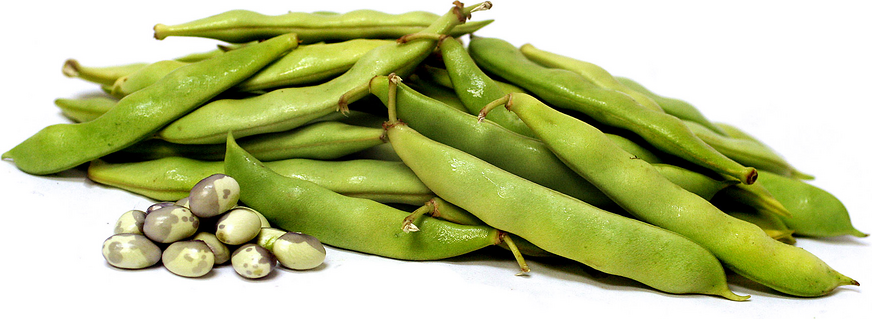


Calypso Shelling Beans
Estimated Inventory, lb : 0
Description/Taste
Calypso shelling beans when fresh are encased in long, narrow bright green pods. Once shelled, the beans are easily distinguished by their skin's trademark yin-yang like pattern, which will become more pronounced with age. Depending upon variety the beans can be found in shades of red and white, tan and white, or black and white. Their coloring will fade somewhat when cooked but not completely like many other vibrant shelling beans. Their shape is petite, rounded and ovate. Cooked Calypso beans will be plump with a velvety smooth texture and will offer a nutty, starchy potato-like flavor.
Seasons/Availability
Fresh Calypso shelling beans are available in summer and fall months.
Current Facts
Calypso beans are an heirloom shelling bean botanically known to be a part of the Phaseolus vulgaris genus, the most widely cultivated genre of beans in the world. Beans in the Phaseolus vulgaris genus such as the Calypso are also known as common beans and are a New World bean. Unlike green beans which are consumed pod and all, shelling beans are grown primarily for their edible seeds or beans contained within the pods. There are several different varieties of Calypso beans with the black and white bean being the most commonly found. The Calypso is also sometimes marketed as Orca bean or Yin-Yang bean, both a nod to the beans unique exterior coloring and pattern. The Calypso is a specialty bean and today most commonly sold in its dried form though they can sometimes be found fresh in the pod at farmers markets when in season.
Nutritional Value
Beans such as the Calypso are high in protein and offer some potassium, iron, zinc, thiamin, magnesium and calcium as well.
Applications
Calypso shelling beans are utilized for the beans contained in their pods. The inner beans can be used when freshly shelled or as a dried bean. When used in their dried state beans should be soaked overnight to make them easier to digest. Shelled beans can also be frozen or preserved in cans and jars and saved for future use. Calypso beans can be simmered, roasted, steamed and sautéed. Calypso beans maintain some of their coloring and hold their shape well when cooked making them ideal for soups, stews, and chili. Cooked beans can also be added to grain, green and pasta salads. Common companions include pancetta, chiles, corn, carrots, garlic, cumin, herbs such as cilantro, sage and oregano, summer squash, chicken, sharp and mild cheeses, citrus and mustard greens. To store Calypso beans keep unshelled beans refrigerated using within a week. Once shelled fresh undried beans will keep for a few days in refrigeration.
Ethnic/Cultural Info
Calypso beans are believed to be one of the beans grown by the Native American tribe, the Abenaki people of the Champlain region. The beans were commonly grown along with corn and squash in a process known as “the three sisters” where the crops all provide natural support for one another. Additionally when all three crops were consumed they together formed a complete protein as well as made for a filling meal which provided sustenance in a time where meat was scarce. The Abenaki would plant the Calypso and the other sister crops when the seven sister star cluster known as the Pleiades was spotted in the early morning sky along with the rising sun, a sighting that signaled the start of spring. Come winter the star configuration would be in the setting sun sky, signaling the end of the season for those crops.
Geography/History
Calypso shelling beans are believed to be native to the Americas, specifically the Caribbean region where they were grown approximately four hundred years ago. Calypso bean plants prefer a Mediterranean climate with at least six hours of full sun a day and soil temperatures between sixty and eighty degrees Fahrenheit. The Calypso bean grows in a bush-like habit and does not require trellising. Beans such as the Calypso not only provide a nutritious food crop, but they enrich the soil where they are planted as well as a result of their ability to fix nitrogen and act as a natural fertilizer.
Recipe Ideas
Recipes that include Calypso Shelling Beans. One
| 101 Cookbooks |
|
Butterscotch Calypso Bean Soup |




